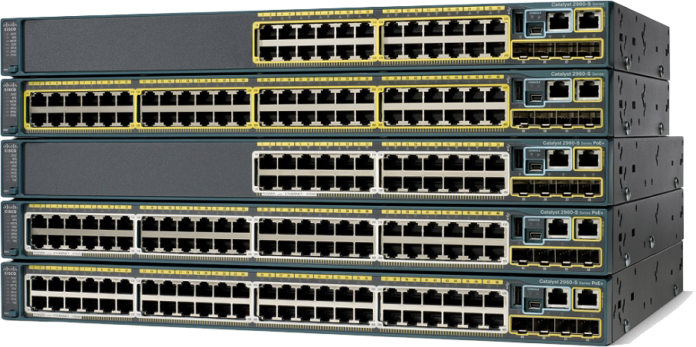
In the ever-evolving world of networking, one of the most common yet crucial devices you’ll come across is a switch. Whether you’re working in a corporate environment, managing a data center, or simply setting up your home office network, understanding what a switch is and why it’s important is essential. But, what exactly is a switch in networking, and why do Cisco switches dominate the scene? Let’s break it down.
The Basics: What Is a Switch in Networking?
Imagine you’re in a crowded room, and you need to send a note to a friend across the room. You could shout, but that would be inefficient and disruptive. Instead, you might pass the note to a specific person who can then hand it directly to your friend. That’s similar to how a network switch works.
In technical terms, a network switch is a device that connects multiple devices on a computer network, such as computers, printers, and servers, allowing them to communicate with each other. Unlike a basic hub, which broadcasts data to all devices, a switch intelligently forwards data only to the device it’s meant for. This not only reduces network congestion but also improves security and efficiency.
Layered Functionality: How Does a Switch Work?
Switches work at the Data Link Layer (Layer 2) of the OSI (Open Systems Interconnection) model, but some advanced switches also function at the Network Layer (Layer 3), which allows them to perform routing tasks as well. Here’s how the process generally works:
- Learning: When a device sends data through the switch, the switch learns the device’s MAC (Media Access Control) address and maps it to a specific port. Think of it as the switch “remembering” where each device is located in the network.
- Forwarding: When data arrives at the switch, it checks the MAC address to determine the correct destination. Instead of broadcasting it to all devices, it forwards the data only to the correct device. This selective forwarding improves network speed and reduces unnecessary traffic.
- Filtering: If a device tries to send data to another device that’s not in the same network segment, the switch will not forward that data, ensuring that communication only happens within the correct segment.
Why Cisco Switches Are a Big Deal
When it comes to switches, Cisco is often the first name that comes to mind — and for good reason. Cisco is a leader in the networking world, known for producing high-quality, reliable, and feature-rich switches that power everything from small businesses to the largest data centers.
Let’s explore why Cisco switches are the go-to choice for so many networking professionals:
1. Reliability and Performance
Cisco switches are renowned for their exceptional reliability and high performance. Whether you’re setting up a small network or running a large-scale enterprise, Cisco’s products are built to handle heavy traffic loads without compromising speed or uptime. This reliability is critical in business settings, where network downtime can result in significant financial losses.
2. Scalability
One of the major advantages of Cisco switches is their scalability. As your network grows, Cisco switches can easily scale to accommodate additional devices and traffic. With advanced features like stackable switches (where you can combine multiple switches into a single unit), Cisco makes it simple to expand your network without overhauling your existing infrastructure.
3. Security Features
Security is a major concern in networking, especially as cyber threats evolve. Cisco’s switches come with advanced security features such as port security, VLANs (Virtual LANs), and Access Control Lists (ACLs), which help prevent unauthorized access and limit the spread of potential attacks. Cisco also supports 802.1X authentication, which requires devices to be authenticated before they’re allowed on the network.
4. Advanced Management and Monitoring Tools
For IT professionals managing complex networks, Cisco offers powerful management tools like Cisco DNA Center and Cisco Prime. These tools allow network administrators to monitor, configure, and troubleshoot their networks with ease. With features like automation, AI-driven insights, and real-time performance monitoring, managing a Cisco-powered network is much more efficient than doing it manually.
5. Support and Ecosystem
Cisco isn’t just a hardware provider; it’s an entire ecosystem. When you buy Cisco switches, you’re also investing in a vast array of resources, including technical support, training programs, and a community of certified professionals. With Cisco’s Certifications (such as CCNA, CCNP, and CCIE), you can ensure that your team is up-to-date on the latest networking technologies.
6. Future-Proofing Your Network
The world of networking is rapidly changing, with innovations like IoT (Internet of Things), 5G, and AI-powered networks reshaping the industry. Cisco’s products are designed with future-proofing in mind, so they can evolve with emerging technologies. Whether it’s supporting higher bandwidth, adopting new protocols, or integrating with cloud environments, Cisco switches are ready for what’s next.
The Different Types of Cisco Switches
Cisco offers a variety of switches to meet different needs. Here are a few of the most popular categories:
- Catalyst Series: These are high-performance, enterprise-grade switches used in large organizations. They offer advanced features for security, scalability, and management. If you’re building a backbone for a campus or data center, the Catalyst series is the gold standard.
- Meraki Switches: Meraki is Cisco’s cloud-managed network solution, and their switches are designed for small to medium-sized businesses. The cloud-based interface allows for easy management from anywhere in the world.
- Nexus Series: These switches are designed for data centers, offering high density, low latency, and support for 10/25/40/100Gb Ethernet. They are ideal for high-traffic environments where speed and scalability are critical.
- Small Business Switches: Cisco also offers a line of switches designed for small businesses, with simpler setups and more affordable price points without sacrificing quality.
Final Thoughts: Why Networking Needs Switches
At the heart of every smooth-running network is a network switch. From handling data traffic to improving security and performance, switches are the unsung heroes of modern digital infrastructure. Cisco’s switches stand out in a crowded market due to their performance, scalability, security features, and future-ready capabilities. Whether you’re just starting to build a network or optimizing an existing one, investing in quality switches like Cisco can make all the difference.
In a world where fast, reliable, and secure connections are more important than ever, understanding how switches work — and why Cisco is the industry leader — gives you a head start in mastering the future of networking.
If You Need Something About Cisco You Can Visit our Website.




Amazing Resource
I appreciate the focus on the switch’s energy efficiency and performance—two key factors for any modern network.
Excellent explanation! I’ve always been a bit confused about the difference between switches and routers, but this post made everything click. I especially appreciated the section on why Cisco switches are trusted in business environments. We recently upgraded to Cisco with help from Jazz Cyber Shield, and the performance + security has been incredible. Thanks for making networking easier to understand!
I’m glad you pointed out the performance differences. The JL681A seems like a great option for enterprises with high traffic, while the JL675A is probably better for smaller, cost-conscious environments.